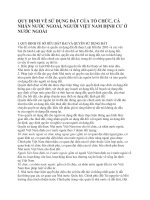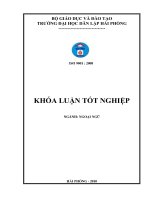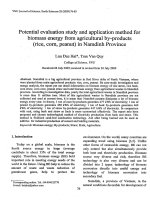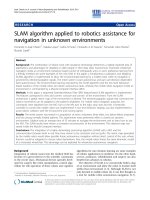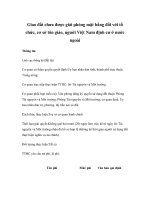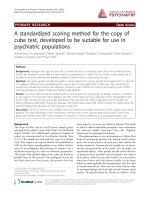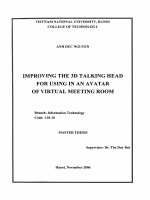Improving policies to develop handicraft for exports in 2020 in nam dinh
Bạn đang xem bản rút gọn của tài liệu. Xem và tải ngay bản đầy đủ của tài liệu tại đây (308.2 KB, 12 trang )
1
INTRODUCTION
1. The necessity of the research
The development of exports of handicrafts have great impact to
promote the development of producing, creating more jobs and income
for rural workers, and contributing greatly to re-assign labour and
restructuring social economy of Nam Dinh province.
There are many factors affecting to the development of exported
handicrafts goods among which state policies have an important role in
the growth and efficiency of exported handicrafts. In recent years, Nam
Dinh province has developed policies for the export of handicrafts
goods. These policies have contributed to assist handicrafts goods
become one of the major export goods of the province. However, the
actual situation of producing and exported handicrafts in Nam Dinh
province over this time reveals some restriction, and does not help the
province promote the potential strengths in this field.
One of the reasons for the restrictions derives from the policies
developing export handicrafts goods of Nam Dinh province from
propagating to realizing the policy. Therefore, there is a need to analyse
and assess the impact of the policy in order to adjust and complete
additional development policies to export handicrafts goods in Nam
Dinh, which is suitable with new situation and growth trends in the
domestic and international area.
Stemming from the above requirements, we have selected the
research topic: "Improving policies to develop handicraft for exports in
Nam Dinh province 2020" as our economic doctoral dissertation.
2. An overview of the research situation and issues for further study
So far there have been many studies locally and in foreign country
relating to the thesis with different approaches and scopes including
economic and social development policy and development of exported
handicrafts goods. However, no studies have resolved comprehensively
and systematically the theoretical and practical problems of assessment,
and improvement development policies for handicrafts goods exports in
Nam Dinh province as well as in other localities in the country.
Therefore, the dissertation will research, develop and apply theoretical
frameworks to assess the real state of development policies for
handicrafts exported goods, and then on that basis, will provide some
recommendations for refining development policies to handicrafts export
goods in Nam Dinh province.
2
3 Research aims and objectives
3.1. Research purposes
The dissertation aims at proposing some contents to complete and
innovate development policy handicrafts exported goods in Nam Dinh
province.
3.2. Objectives of the study
The objectives of the dissertation are to
- Develop assessment methods, purify development policy for the
local handicrafts exports.
- Review and evaluate the impact of policies related to the
development of handicrafts goods exports in Nam Dinh, pulled out
the strengths, weaknesses and policy reasons.
- Propose contents to purify development policy of handicrafts
export goods in Nam Dinh.
4 Subjects and study area
4.1. Research Subjects
The object of the research is the policies of Nam Dinh province
which impact on the development of handicrafts export goods.
4.2. Scope of the study
- Field: Assessing, no policies to develop handicrafts export
goods within the area of Nam Dinh province.
- Time: Some impacts of development policies to handicrafts
exported products in Nam Dinh province in 2006-2012.
5. Research Method
5.1. Research model
- Develop theoretical
framework to evaluate,
perfect development
policies for handicrafts
exported goods.
- Develop criteria to
evaluate development
policies for handicrafts
export goods.
- Draw some lessons about
development policies for
handicrafts in some
countries and localities in
the country.
- Assess the impacts
of development
policies for
exportting
handicrafts goods of
Nam Dinh province
through the
evaluation criteria.
- Draw on the
strengths and
weaknesses of the
policy and the
causes of these
factors
Propose some
con
tents to
complete
development
policies for
exported
handicrafts
goods
in Nam
Dinh
province.
3
5.2. Research Method
The dissertation applies dialectical materialism methodology
combined with logic, history and survey methods, survey and statistical
analysis, using experts and forecasts.
6. Contribution of the Dissertation:
6.1. Theory:
- The dissertation clarifies the contents relating to policies
developing exported handicrafts, procedures to improve the policies, in
which factors affecting to these policies have been indicators.
- The dissertation draws some lessons in policies to develop
handicrafts exported to some countries and localities in the country.
These lessons are basis for reference, to apply and develop policies to
exported handicrafts in Nam Dinh province.
6.2. In practice:
- Analyze and evaluate the impact of policies to the development
of exported handicrafts in Nam Dinh province period 2006-2012,
indicating the strengths and weaknesses of the policy, the causes of
weakness.
- Propose the complete contents to perfect policies developing
handicrafts exported in Nam Dinh province and recommend measures to
implement policies.
7. Dissertation Structure
Besides the introduction and conclusion, the dissertation has three
chapters are presented in 148 pages
Chapter 1
THEORETICAL BACKGROUND OF COMPLETING POLICIES
DEVELOPING EXPORTED HANDICRAFTS AND EXPERIENCE
IN POLICIES DEVELOPING EXPORTED HANDICRAFTS
1.1. Exported Handicrafts
1.1.1.The definition, features exported handicrafts
Definition: Handicrafts are often viewed as the product produced
mainly by manual methods. These products have high aesthetic
associated with customs and the culture, and imbued with the culture of
area creating the goods. Handicraft products are often traditional
products of a locality or a nation.
Features: Exported handicraft goods have some basic
characteristics which are different from other goods in term of the nature
4
of the product, the consumer, the materials, the producer and method to
produce them.
1.1.2. The importance of exportting handicrafts in the culture,
economic and social development of the province.
1.1.2.1 For the social and economic development
Play an important role in creating jobs, income, and reasonable
use of labor in rural areas; Increase revenues and export efficiency
1.1.2.2 For conservating and developping traditional culture
To preserve, maintain and develop various traditional sectors of
the province. ;To preserve and develop the traditional culture values and
spread culture to other countries.
1.1.3 Supply Chain exported handicrafts goods
Chart 1.1: Supply Chain exported handicrafts goods
Source: [12]
1.1.4. Contents to develop exported handicrafts
1.1.4.1 Developing production scale and capacity
Including
: Developing handicraft villages producing handicrafts,
workshops to produce and do business, human resources, material
resources, capital investment, increase production value and revenue.
1.1.4.2 Developing Export
Including
: Increase exports; develop new and high value-added exported
handicraft products, exploit, expanse, develop new export markets.
5
1.1.4.3 Improving the effectiveness of business manufacture
- Improving labor productivity
- Increase business profits of handicraft goods
- Improving the efficiency of using capital
1.1.5. Factors affecting to the development of exported handicraft in
local areas
1.1.5.1 The production condition and factors
ncluding
: Natural conditions; infrastructure; capital, labor force,
materials, techniques and technologies; Traditional elements
1.1.5.2 The product consumer market
- Exporting market
- Substitute products
1.1.5.3 The competitors in exported handicraft industry
- Competition among the handicraft industry in local areas in the country
- Competition among countries exported handicrafts
1.1.5.4 The supporting industries and sectors relating to exported
handicrafts
The development of sub-industries to facilitate production and
development of exported handicrafts.
* A stable socio-economic-political environment will create
favorable conditions for business.
* The impacts of the management, administration and legal
environment of the State to production of exported handicrafts:
- The policies and strategies of the Government in encouraging the
development of handicraft industry
- The policy in developing export of the state.
- The cooperation in direct and executive management agencies
from the central to local levels in developing exported handicrafts.
* Tariff barriers and non-tariff of the importing countries
1.2. Policy to develop exported handicrafts in provinces
1.2.1. Definition of policies to develop exported handicraft goods
From the analysis of the definitions of socio-economic policies, it
is stated that policies to develop exported handicraft goods are the state
guidelines, solutions affecting to objects in the supply chain of exported
6
handicrafts in order to develop elements for developing exported
handicraft goods.
Policies to develop handicraft products for export can include
policies of the central and local governments.
1.2.2 The basic elements of policies to develop exported handicrafts
goods
1.2.2.1 Pursuant of the policy
1.2.2.2 Objectives of development policies for exported handicraft goods
General objective:
- To develop production, export handicrafts, create jobs and
incomes for workers.
- The specific objectives to fulfill general objectives such as
developing capital, labor, land, technology, market
1.2.2.3 The subject and object of policies to develop exported handicraft
- The subject of the policy are the individuals, the state
management organizations involving to the process of developing
management policy.
- The object of the policy are handicraft villages, business bases
producing raw materials and exported handicraft products.
1.2.2.4 The principles to implement objectives of the policy
The point of view directing the behavior of the key actors of the
policy in the process of planning and implementing policies.
1.2.2.5 The module of policies to develop exported handicrafts
The module of the policy can be classified according to: Scope of
impact, the object of the policy or specific objectives of the policy.
1.2.2.6 Solutions and tools of the policy
- There are measures affecting directly to the target, but there are
solutions indirectly affect to the target.
- Tools of the policy include: economic tools, administrative tools -
organization, technical and professional tools.
1.2.3. The main components of the policies to develop exported
handicrafts
There are many ways of classifying policies, to fit the research
objectives of the dissertation, policies for development of exported
handicrafts can classified into 9 policy components including:
7
1.2.3.1 planning to develop exported handicrafts
1.2.3.2 Product Policy
1.2.3.3 The policy for materials development
1.2.3.4 Land Policy
1.2.3.5 Investment policy and credit
1.2.3.6 The policy for human resources development
1.2.3.8 The policy for technological development
1.2.3.8 Environmental Protection Policies
1.2.3.9 Policies for trade promotion, and market development
1.2.4. The process of policy to develop exported handicrafts
Notes:
Chart 1.3: The process of policy to develop exported handicrafts
Source:[14. pp.32]
1.3. Improving policies to develop exported handicrafts
1.3.1 The necessity to improve the policy
- Limitation about information of policy makers.
- The errors in policy implementation.
- Environmental changes therefore, policies are no longer appropriate.
1.3.2 The steps to improve policies
1.3.2.1 Identifying factors needed evaluating policyies
Showing the circulation in the policy cycle
Showing a direct relationship
Maintaining
Policy
Identifying
Policy Issues
Making Policy
Implementing
Policy
Analyzing
Policy
Assessing
Policy
Identifying
Conflicts
8
- The impact of the policy could change or could not chang the
development of handicrafts sector for export.
- The appropriate of policy objectives.
- The degree of responsiveness of the budget for the policy
implementation.
- Measures and tools for policy implementation.
1.3.2.2 Assessing policy to develop handicrafts goods
* Assessing the impact of the policy system to the development of
the industry through the analysis of "rate of change"
# Selecting the object and the time scale to evaluate.
Survey respondents are those who benefit the policy and the
evaluation period "rate of change" is from the time when the policy was
issued to the time of the study.
# Define the evaluation criteria "degree of change"
(1) Assess the scale changes, production capacity
- The variation of the handicraft villages, and workshops
producing handicrafts.
- The fluctuation of the average scale in production industry.
- A change in the quantity and quality of labor.
- Evaluation of "change rate" in capital source, capital structure.
- Assessment of changes in raw materials.
- Evaluation of "change rate" in production value, and revenue
(2) Evaluation of the changes in exported handicrafts results
- Evaluation of the fluctuation in export turn-over.
- Fluctuations in basic market structure, the fluctuation in number
of market, fluctuations in commodity sales in each market.
(3) Assessment of change rate in production and business
efficiency.
- Assessing the fluctuation of labor productivity
- Assessing the variation in profit.
* Assessing the implementation results of policy objectives
Using a logical policy framework to evaluate relationship
between the outcome of the planning and organizing process, and
control of the policy implementation
- Compare actual results with set targets.
- Analyze the problem such as: If the policy target is on the right
orientation; if the target structure is appropriate? Why?
* Assessment of the policy implementation
9
- The scale in which the policy has been implemented
- The scale in which the policy has been introduced
* Using policy matrix to assess the impact of policy
components to the development of handicrafts for export
No
Policy
Name
The weighting
of each policy
Impact Scale of
each Policy
Level of
General
Impact
1
2
…
1 A =
1.3.2.3 Identifying the strengths and weaknesses of the policy and the
reason
* The policy strengths:
* The policy weaknesses:
* Reasons of the weakness:
- The causes deriving from the policy quality, organization of
policymakers.
- The causes deriving from organizing and implementing the policy.
1.4 Experience in policy to develop handicrafts for export
When conducting research in policies to develop handicraft villages
and rural handicraft industries in which there are exported handicrafts
from Japan, Thailand, Hanoi and Thai Binh, the author has drawn a
number of lessons which can be applied to the study of improving
policies to develop handicrafts for export in Nam Dinh province.
- Developing exported handicrafts sectors should be connected to
the rural industrialization process.
- Product policies - "Every handicraft village has one handicraft
product" campaign.
- Policies to support workforce training.
- Policies to support investment, credit, tax.
- Policies to promote trade and communications.
- Agree on the direction, management and implementing policies
to develop handicraft industry.
10
Chapter 2
ASSESSMENT OF POLICIES TO DEVELOP HANDICRAFTS FOR
EXPORT IN NAM DINH PROVINCE IN THE PERIOD 2006-2012
2.1. Factors affecting the development of handicrafts for exports in
Nam Dinh province
2.1.1. The favorable factors
2.1.1.1 The internal factors of Nam Dinh province creating the favorable
conditions for the development of handicrafts for export
- The systems of roads, power, information have been invested quite
synchronized to create favorable conditions for economic and social
development of the province.
- Nam Dinh province has a number of plants for materials such as jute,
rush, mulberry, wood, bamboo and rattan for handicrafts production.
- Nam Dinh province has the tradition in manufacturing and exported
handicrafts with many famous traditional handicraft villages and a
number of artists, skillful craftsmen, and skillful team of craftsmen.
2.1.1.2 International and domestic status has some advantages for the
development of handicrafts for export
- Exported products from Vietnam have been treated equally as
products from other WTO members.
- Government has great efforts in institutionalizing legal,
reforming administration, creating favorable conditions for production
and business.
- The guidelines and policies of the Party and State are cared
about the development of rural handicraft industries, cottage industries.
2.1.2 Drawbacks for the development of handicrafts for export in Nam
Dinh province
2.1.2.1 The difficulties deriving from the internal factors of Nam Dinh
province
- PCI index of Nam Dinh is still low, because budget funding is
low; therefore, policy supporting the handicrafts development is limited.
- The handicrafts trading and producing workshops are facing to
difficulty in finance, production premises; technology in processing raw
materials and manufacturing are low; workforce quality of handicraft
sector is generally low; handicraft producing is still small and scattered.
11
2.1.2.2 Difficulties deriving from handicraft importing countries
- The major importing countries are currently deployed anti-
subsidy measures, anti-dumping regulations; therefore management,
quality control of imported products are very strict.
- Some markets tend to import handicraft products which are
mass produced by machines.
2.2. Policy enforcement to develop handicrafts for export in Nam
Dinh province in the period 2006-2012
2.2.1 Land Policy
In order to have land for developing industry and handicraft, the
province has had a plan until 2020 to have 12 industrial zones with a
total area of 2,040 ha and 31 industrial complexes with a total area of
615.3 ha.
Along with planning, Nam Dinh province has published policies
to support the development of industrial clusters such as policy to
support infrastructure development in My Trung Industrial Zone in
2005; A number of mechanisms and policies to encourage investment in
construction and infrastructure in business zones and investing industrial
production and business in industrial zones in Nam Dinh province in
2008; Mechanisms to encourage investment in the development of
industrial clusters and cities in Nam Dinh province in 2006; regulatory
policies to encourage and support investments in the industry of the rural
areas in the southern of the province in 2012 with the support in
constructing roads, electricity, water, communication, compensation and
ground clearance, land rent
In the early 2000s, the province did not have any industrial zones
and complexes; however, by 2012, there had been four industrial zones
with a total area of 714 ha, a total investment of 2,615 billion VND.
Basically, infrastructure of these zones has been built and these
zones attract investment in production projects. Twenty industrial
clusters have been deployed infrastructure with a total area of 338.9 ha;
total investment was 198.67 billion VND.
2.2.2 Investment policy, credit
Policies supporting investment and credit were issued in a
mechanism to encourage investment in the development of industrial
clusters in districts and cities in Nam Dinh province. A number of
mechanisms and policies to encourage investment in construction,
infrastructure of business and industrial zones, and investment of
12
manufacturing industrial zones in Nam Dinh province and regulations
and policies to encourage and support investment in industrial locations
in rural areas of Nam Dinh province.
With the investment policy, credit, up to 2012, 98 enterprises
invested into industrial zones; there were 401 investment projects in
industrial clusters, of which 108 projects relating to producing
handicrafts; capital for developing handicrafts increased from 137.6
billion VND in 2005 to 872.9 billion VND in 2012, of which over 50%
were from credit loans.
2.2.3 Policy in Training Human Resources
Policy in training human resources for handicraft industry was
issued in "Management Regulation and using funds from economic
services for industrial promotion activities" in 2005, "Mechanism to
encourage development of industrial cluster in districts and the cities in
Nam Dinh province; the Project "vocational training for rural workers in
Nam Dinh province in 2020” and "Regulations in management and
using funds for economic services for industrial promotion activities in
Nam Dinh” in 2012. With the policy supporting to professional training
for employees, from 2006 to 2012, 10,045 workers working in
handicrafts industry trained in short courses organized from the
recommended budget and funding for training rural labor villages.
2.2.4 Technological Development Policy
The policy of the province in developing technological for
handicrafts sector is specified in the "Regulations in managing and using
business funding for economic industrial promotion activities" in 2005
and "Regulations in managing and using business funding for economic
industrial promotion activities in Nam Dinh" in 2012. By 2006-2012, the
provincial budget had supported 7 projects in delivering, applying
modern machinery, advanced technology in the production phases, and 9
technical demonstration models in producing handicrafts with the total
cost 2,325 billion VND.
2.2.5 Environmental Protection Policy
Nam Dinh provincial People's Committee issued Action Plan 54 /
PPC-VP3 implement Resolution No. 41 / NQ-TW dated 15.11.2004 of
the Ministry of Politics in environmental protection during the period of
industrialization, modernization of the country and since 2007, the
13
province has spent 1% of the total annual budget for environmental
protection activities.
Total expenditures on environmental protection activities in 2006
- 2012 was 542.371 billion VND. In particular, investment in waste
water treatment projects, waste from industrial zones and industrial
complexes, the handicraft village was 44,703 billion VND, constructing
landfill waste disposal was 144 430 billion VND.
2.2.6 Business Promotion and Market Development Policy
Business promotion policies are presented in the "Regulations in
managing and using business funding for economic industrial promotion
activities in Nam Dinh" in 2005, 2012, and "Regulations in managing
and using business funding for business promotion activities in Nam
Dinh" in 2010 to assist to organize exhibitions in the province, and to
assist businesses to participate to trade fairs locally and abroad
In 7 years (2006-2012), the provincial budget supported more than 90
handicrafts enterprises to participate into trade fairs in the country and
abroad and held 30 trade fairs in the province with a total over 700
participating businesses.
Thus, compared to 9 components of policies mentioned in section
1.2.3 to develop handicrafts for export, the Nam Dinh still lacks three
policy components: planning to develop handicrafts for export; Product
policy; Policy to develop material resource. These policies need adding
to improve development policies for exported handicrafts in Nam Dinh
province.
2.3. Evaluating policies to develop handicrafts for export in the
period 2006-2012 in Nam Dinh Province
2.3.1. Evaluating the impact of these policies to develop handicrafts for
export in Nam Dinh period 2006-2012
2.3.1.1 The impact of policies to the development of scale, production
capacity of exported handicrafts
a, Developing handicraft villages, production of handicrafts workshops
In 2005, Nam Dinh province had 37 handicraft villages; in 2012
this number handicraft villages was 43.
In 2005, the province had 6378 workshops producing handicraft
products, including 45 enterprises; In 2012 this number rose to 8183
workshops, including 81 companies. After 7 years, this number
increased by 1,805 workshops.
14
b, The changes in scale of workshops producing handicrafts
- The average scale of workshops by the number of employees
was rather stable over the period 2006-2012, on average there were 3.4
people/ workshop.
- The average scale of workshops by capital was from 21.6
million VND/workshop in 2005 to 106.7 million VND in 2012, which
increase 85.1 million VND/workshop.
- The average scale of workshops by the value of producing
workshop increased from 32.5 million VND in 2005 to 74.7 million
VND in 2012.
- The average scale of workshops by revenue also increased from
81.3 million VND in 2005 to 191.7 million VND in 2012.
c, Labor changes in the handicraft sector.
- Total number of employees in the sector: in 2005, there were 21
498 employees, 27 435 employees in 2012, after 7 years this number
increased by 5,937 employees.
- The percentage of employees trained (from short-term to
university) increased by 13.6% after 7 years (from 52.7% to 66.3%); the
proportion of untrained workers fell from 47 , 3% in 2005 down to
33.7% in 2012
d, "The change scale" in capital, and capital structure
- The total capital of the whole sector increased from 137.6 billion
VND in 2005 to 872.9 billion VND in 2012; after 7 years, this number
increased by 735.3 billion VND.
- The proportion of the total equity capital of the enterprises was
74.6% in 2005, by 2012 there was only 53.3%. The proportion of loans
in 2005 was 25.4%, and 46.7% in 2012, down to 21.3% after 7 years.
e, The rate of change of source materials
Nam Dinh does not have policies to support for the development of
the production materials for handicrafts; therefore, since 2006-2012
from materials from plants reduce both in the area and exploited outputs.
f, The change in production value and sales:
- The value of handicrafts production (according to fixed price in
1994) increased by an average of 16.7% / year: In 2005 it reached 207.4
billion VND, in 2012 it reached 611.5 billion VND, which increased
404.1 billion VND compared with this number in 2005.
- Revenue of the whole handicrafts industry (according to current
prices) increased by an average of 17.3% / year: In 2005 it only reached
15
518.6 billion VND, in 2012 it reached 1568.9 billion VND, which
increased 1050.3 billion VND compared with this number in 2005.
2.3.1.2 Impacts of the policy to export of handicrafts
a, The changes in turnover, export structure
- Exports of handicraft products in 2006-2012 period on the
average increased 14.53% / year; in 2005 reached 9,654 million USD, in
2012 reached 24,952 million USD, which increased 15.928 million USD
compared to this number in 2005.
- The structure of exported products:
Export of rattan is relatively stable and it accounts for more
than 50% of total turn-over of exported handicrafts. Items such as
jute, seagrass, banana have slight growth. Products of engineering
handicrafts and fine art furniture have a gradual growth, and they
gradually make up a high proportion in the total of export turn-
over of handicrafts.
b, Evaluating the "change rate" in the export market:
- Export market of handicrafts in Nam Dinh province increased
from 31 markets in 2005 up to 42 markets in 2012.
- The changes of the basic market structure:
EU market: The ratio of export turn-over to the EU market
gradually decreased from 63.76% in 2005 down to 48.32% in 2012;
Northeast Asia Markets: The proportion of export turnover slightly
increased from 15.53% to 17.01% in 2012; Eastern European and
Russian markets the export turnover decreased from 12.85% in 2005 to
11.63% in 2012; Market in the USA: The proportion increased from
4.23% in 2005 to 12.97% in 2012; Other markets including Singapore
and newly exploited markets since 2005: The propotion gradually
increased from 5.6% in 2005 to 9.98% in 2012.
2.3.1.3 Evaluation of the efficiency of development in production and
business
- Fluctuations in labor productivity: The average labor
productivity under production value / year increased from 9.6 million
VND in 2005 to 22.3 million VND in 2012; and under sales/ year
increased from 24.1 million VND in 2005 to 57.1 million VND in 2012.
- Gross margin of the companies in this industry in 2005 was 35.6
billion VND, and in 2012 was 79.4 billion VND, which increased 43.8
billion VND compared to this number in 2005.
16
The average profit/per employee was 23.3 million VND in 2012, which
12.4 million VND increased compared to this number in 2005. The
average profit margin/per VND capital in 2005 was 0.228%, 0.012% in
2009, rose to 0.126% in 2012 but it was lower than that in 2005.
2.3.2 Evaluating results in implementing goals developing handicrafts
for export in Nam Dinh province in the period 2006-2012
Table 2.22: Evaluating results in implementing goals developing
handicrafts for export in Nam Dinh province in the period 2006-2012
Target Period 2006-2010 2011-2012
Target Result Assessment Target Result Assessment
The average
growth rate of the
production value/
year (%)
20 15,4 Fail 22 20,1 Fail
The average
growth rate of the
export turnover/
year (%)
16 12,5 Fail 16 19,4 Pass
Export turnover in
2010, 2012 (1.000
USD)
20.300 17.458 Fail
23.898
24.952
Pass
Source: Summary from research of many researchers
2.3.3 Evaluating the implemention of the policy for developing
exported handicrafts in Nam Dinh province
Through the summarized survey results (Table 2:25 and Table
2:26), it is showed that the percentage of objects unknowing the policy is
quite high and the rate of those benefitting the policy has been low.
Besides, the dissemination and policy guidelines for the business and
production workshops are still limited.
2.3.4 Assessing the impact of each policy component of the policy to
develop handicraft for export
According to results synthesized from the survey (Table 2.28) the
dissertation identifies the number and impact level of each component of
policy to the development of exported handicrafts, which is the basis for
the completion and improvement of the policy implementation. Among
the policies, policy to promote trade and develop markets plays a very
important role.
17
2.3.5. The strengths and weaknesses of each policy to develop
handicrafts for export in Nam Dinh province
2.3.4.1 Strengths
Firstly, the policies have a positive impact on the development of
factors coming from production to exported handicrafts market.
Secondly, the policies have had a positive impact on the results of
operating and producing handicrafts.
Thirdly, the policies were constructed, issued by Nam Dinh
province on the basis of specifying guidelines and policies of the central
and applied in accordance with the specific situation of the province.
2.3.4.2 Weaknesses
Firstly, the policies are insufficient and not synchronized.
Secondly, the support level from the budget of some departments
is still low, which causes difficulty in implementing.
Thirdly, some policies have no resources to implement.
Fourthly, some inconsistent policies have not been amended, and
some overlapping policies cause difficulty in implementing.
2.3.6. The reasons of the weakness of policies to develop handicrafts
for export in Nam Dinh Province
2.3.6.1 Reasons deriving from organizing the policies
Firstly: All levels and branches have not really cared for leading,
directing the planning, developing policies in producing handicrafts for
export.
Secondly, there is an inconsistence in organizing, researching,
policy making and monitoring policy, implementing; therefore, policies
to develop handicrafts for export are not consistent, and overlapping.
Thirdly, the staff issuing and advising policies have limited capacity.
2.3.6.2 The reasons deriving from organizing implementing policies
Firstly, the assigning roles to implement the policies to develop
workshops in rural areas is still overlapping.
Secondly, at district, commune, there are not many skillful and
sufficient staff to guide and implement the policies to develop
workshops in rural areas.
Thirdly, a number of policies to encourage the development of
handicrafts have been issued but have been implemented slowly.
Fourthly, there are barriers between the policies realizing and
implementation.
18
Chapter 3
ORIENTATION AND CONTENTS TO IMPROVE
POLICIES TO DEVELOP HANDICRAFTS FOR EXPORT
IN NAM DINH PROVINCE BY 2020
3.1. Perspective, orientation, goals to develop handicrafts for export
by 2020 in Nam Dinh
3.1.1. Development viewpoints
Firstly, all the industry at all levels need to be aware of the role of
producing, and exporting handicrafts.
Secondly, developing handicrafts production must link to the
process of industrialization - modernization in rural areas to efficiently
use resources such as land, labor, capital, raw materials
Thirdly, developing handicrafts production should associate with
developing tourism in order to exploit the potential values of developing
tourism with traditional villages and developing export (export on the
spot).
Fourthly, producing handicrafts to export must bring socio-
economic efficiency.
Fifthly, developing handicraft production must go along with
constructing new countryside, maintaining the traditional and cultural
values of the country.
Sixthly, developing handicraft production must link with
protecting the ecological environment, ensuring sustainable
development.
Seventhly, the Government supports by passing policies to
develop the internal resources of the handicraft villages, and business
workshops.
3.1.2. Development directions
Firstly, in the manufacturing and developing production, it is
necessary to combine between specialization and diversification in
producing.
Secondly, workshops should be active in generating product sales
while producing, focusing in design, innovating product design.
Thirdly, developing export market on a direction to diversify
markets and forming key markets.
Fourthly, jointing ventures with foreign companies to develop
exports; actively participate in the global distribution network.
19
Fifthly, developing handicrafts for export should primarily base on the
development of handicraft villages; at the same time should concentrate
to develop production in industrial zones, industrial clusters villages.
3.1.3 Objectives to export handicrafts by 2020
- To focus on developing strategic exported handicrafts of the
province. They are as following:
Group 1: Exported handicraft commodities using much labor-
intensive, creating more jobs for citizens, improving living standards for
people in rural areas: bamboo and rattan products, lacquer, sedge
products, embroidery.
Group 2: Exported handicraft commodities applying technology,
machinery and equipment in a number of stages, using skilled labor to
create high value products to increase exports turnover: fine art
furniture, art metal ware.
- Target plan to export handicrafts:
Table 3.1: Plan to export handicrafts of Nam Định province
in the period 2013-2020
Unit: thousand USD
Commodity
Year
2012
2013
2015
2020
Total export turnover of
handicrafts
24.952 28.532 37.135 76.890
1 Rattan, bamboo 11.627
13.214
16.940
35.114
2 Mechanical art 4.405
5.099
6.893
14.260
3 Art wood 5.985
6.963
9.197
20.798
4 jute, seagrass, banana 2.130
2.373
2.975
4.987
5
Woolen carpets,
embroidery
, silk
805
883
1.130
1.730
Source: [56], [58]
3.2. The viewpoints and orientations to improve policies to develop
handicrafts for export in Nam Dinh Province
3.2.1. The viewpoints to improve policies to develop handicrafts for
export in Nam Dinh Province
Firstly, applying properly and flexibly policies and laws of the
country to the specific conditions of the province.
Secondly, improving the policies to meet the requirements of
developing the economy-oriented socialist market, with the deeper
integration and international.
20
Thirdly, improving the policies on the principle of respecting the
autonomy and not discriminating production and business workshops.
Fourthly, improving the policies on the basis of combining long-
term vision with short-term vision. Besides, the policies must have a
long-term stability.
Fifthly, improving the policies must ensure the harmonization the
benefits of the country and organizations with benefits of individuals
benefiting these social policies.
3.2.2. The orientations to improve policies to develop handicrafts for
export in Nam Dinh Province
Firstly, improving the policies in the orientation to uniform,
synchronous, and completing with an aim to promote sustainable
growth.
Secondly, improving the policies should be appropriate with policy
planning, plans and objectives to develop socio-economic of the
province.
Thirdly, improving the policies must achieve the goal in
promoting the potential and strengths of the province.
Fourthly, the policies must be feasible and easy to be
implemented.
3.3. Contents to improve policies to develop handicrafts for export
in Nam Dinh Province
3.3.1. Construction Planning to develop handicrafts for export in Nam
Dinh province including
3.3.1.1 Planning to conservative, develop traditional handicraft villages.
3.3.1.2 Planning to develop new handicraft villages.
3.3.1.3 Planning to develop tourism in handicraft villages.
3.3.1.4 Planning industrial clusters, industrial locations.
3.3.2. Constructing Product Policies
3.3.2.1 Developing and implementing the campaign "One Village One
Product" (OVOP).
3.3.2.2 Developing and promulgating regulations to vote typical rural
industrial products
3.3.2.3 Increasing support to construct, register and develop brands.
3.3.2.4. Encouraging professional development, and developing
handicraft villages.
3.3.3 Develop policies to develop material resources
- The policies to develop the material areas: Seagrass, mulberry, jute.
- The policies to develop processing places, processing raw materials.
21
- The policies to develop markets providing materials producing
handicrafts.
3.3.4. Improving the land policies
a. Policy supporting industrialization, industrial locations
b. Policy to recovery, compensation and land clearance
- The policy to compensate of the land acquisition, and clearance.
- The policy to support in career transition for farmers whose land
is recovered.
3.3.5. Improving policies relating to investment and credit.
a. Investment policy:
- Supporting in making detailed plan ICs.
- Adjusting to upgrade support in infrastructure construction ICs.
- Socialization policy to construct industrial zones.
b. Credit and tax policies
- Considering to prioritize handicrafts in loaning,
- Supporting Interest rate for organizations and individuals to invest
in professional development and village handicrafts.
- The tax cuts for village handicrafts products.
- The credit institutions should create favorable conditions for
business handicraft workshops to access loans.
3.3.6 Improving the policy in human resource development
3.4.6.1 Policy for artisans and skilled craftsmen, designers handicrafts
products
a. Prioritizing and promoting the role of artisans and skilled craftsmen.
b. Supporting to training and re-training for artists, skilled craftsmen,
designers of handicraft products.
3.4.6.2 Supporting to vocational training for handicrafts employees
3.3.7 Improving technology policy
- Raising the support level for demonstration techniques in handicrafts
producing to encourage modernization traditional technologies.
- Supporting to enhance production capacity, product quality.
- Policies in sponsorship, financial support, loans and loan interest for
research, technology transfer projects through Science & Technology
development fund of the province.
3.3.8. Improving the protection policy and environmental remediation
villages, industry zones, rural industrial locations
- Providing financial support to build a pilot model of a system to
handle environmental pollution in producing handicraft workshops.
22
- Passing policies to support to re-locate producing workshops in the
handicrafts village causing pollution to industrial concentration cluster.
- Encouraging environmental protection and remediation under the
form of investment support for producing workshops accepting
conversion or applying cleaner production.
3.3.9. Improving support policy in trade promotion
- Adjusting to increase the funding support for the companies
participating in the exhibition domestically and abroad in accordance
with geographical distance, cost of participation fair.
- Additional support fund to organize the intensive training
courses specializing in import and export business, trade promotion and
foreign languages.
- Honor, prioritizing and supporting businesses achieving
"Exporters prestigious" in the trade promotion activities.
- Supporting handicrafts producing models investing showrooms
to promote and introduce products at the tourist destinations.
-
Policies to support
e-commerce
development
.
3.4. Conditions to ensure implementation of policies for developing
exported handicrafts in Nam Dinh province
3.4.1 Central continue to improve the macroeconomic policy of
encouraging the development of handicraft industry
-
The
Central Government
should continue to
develop
,
adjust and
finalize policies to develop handicraft industry
-
To clearly define the
functions
and tasks
for
ministries and
agencies
in
the development for
handicraft
industries
.
3.4.2 The state management bodies of Nam Dinh province have
coordination, assignment of responsibilities in implementing and
solutions to develop handicrafts for export
- Enhancing the quality, uniformity and efficiency in the
development and implementation of socio-economic planning, sectors.
- Ensuring resources for the implementation of policies to develop
handicrafts for export:
- Strengthening coordination capacity in implementing policy
between the related industries, between industry and local management.
- Continue to promote the reform of administrative procedures.
3.4.3 The effort from the producing handicraft workshops
- Find out, take advantages of support from the policies
- Positively, proactively organize producing and business activities.
- Actively participate into the handicrafts industry associations.
23
CONCLUSION
Improving policies on developing local handicrafts for exports is
still a relatively new issue in Vietnam because there has not been any in-
depth study in both theoretical and practical. The dissertation research
on "Improving policies to develop handicraft for exports in Nam Dinh
province 2020" to contribute to the development of a theoretical basis
and practical to improve policies to develop handicraft for exports in the
province. Within the scope of the study, a dissertation has achieved the
following results:
Firstly, the dissertation clarifies the content and the factors
influencing the development of exported handicrafts, the contents of the
policies relating to development of exported handicrafts in the province;
Proposing steps to improve policies, in which the dissertation has
constructed indicators to assess the impacts of policies to the
development of local handicrafts for export. These are problems have
not been mentioned in any previous studies.
Secondly, the dissertation summed up some experience in issuing
and implementing policies to develop handicrafts for export in some
Asian countries and provinces in the country, from which the
dissertation has drawn some lessons which can be applied to construct
and improve the policies to develop handicrafts for export.
Thirdly, from the impact assessment of policies to develop
handicrafts for export in Nam Dinh period 2006-2012, the dissertation
showed that: policies to develop handicrafts for export in Nam Dinh has
had an impact in increasing the production scale, market development,
which leads to the growth in the production results, export of
handicrafts in terms of production value, revenue and exports. However,
there are still some major limitations: (1) there is no plan to develop
handicrafts products, product policy, material development policy; (2)
There is no support to a number of fields such as incentives, training
artisans, skilled workers, designers; budgetary support from the state
budget for the infrastructure construction industry clusters, workforce
training, science and technology, trade promotion, environmental
pollution treatment is low.
The limitations of the policy has led to the
limitations in developing handicrafts for export in Nam Dinh so far: the
spontaneous production, small scale, lack of production sites,
environment pollution, passive in resource, limitation and un-
appropriation in developing and designing new products.
24
Fourthly, the dissertation proposes some contents to improve
policies to develop handicrafts for export in Nam Dinh in two basic
groups: (i) Develop new development plan to produce handicrafts for
export, product policy, developing material resources; (ii) adjusting and
supplying to overcome the limitations of policy in the field of land and
investment-credit, human resource development, science and
technology, environmental protection, trade promotion, in which the
province should particularly focuses on developing policies to support
the export market.
For effective implementation the policies to develop handicrafts
for export in Nam Dinh, author of the dissertation provides some
recommendations as follow:
(1) For the Government and the ministries, central agencies:
The Government does research to establish the National Steering
Committee of handicraft industry to improve coordination among
agencies at both central and provincial levels. This Committee has the
function of coordinating activities and consulting policy relating to the
development of handicraft industry for the government and the
ministries and agencies.
(2) The People's Committee of Nam Dinh province:
Developing and promulgating "primary mechanism to encourage the
development of handicrafts for exports within Nam Dinh province" on
the basis of integrating, adjusting and supplementing the present policies
and new policies relating to the development of handicrafts for export.
The authors hope that the findings of the dissertation will be
considered by Nam Dinh provincial government and the nearby areas,
apply to the issuance, steering implementing policies to develop
handicrafts for export in. However, due to limitations of time, finance
and personal abilities, the author cannot go deeply into the study to
assess the effects of the policy impacts on the policies to develop
exported handicrafts in Nam Dinh province by analytical tools and
benefit costs (Cost & benefit analysis - CBA), which requires a process
of investigation, survey, data collection reflects on a widespread scale.
This can become a further direction for further research in later work of
the author himself or other organizations, other researchers about the
human resource conditions, the financial basis for the constructing,
completing policies to develop handicrafts for export in order to bring
more effectiveness when implementing these policies.
